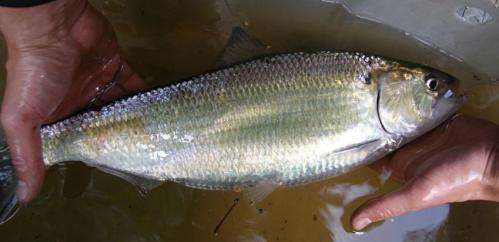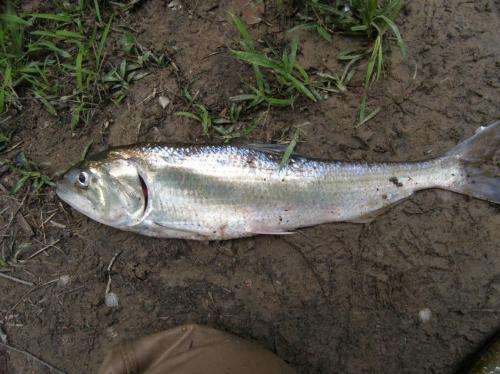Dam removal improves shad spawning grounds, may boost survival rate

Research from North Carolina State University finds that dam removal improves spawning grounds for American shad and seems likely to improve survival rates for adult fish, juveniles and eggs – but for different reasons.
The researchers focused on a small tributary in North Carolina called the Little River, where three dams were removed in the late 1990s and early 2000s. American shad (Alosa sapidissima) spend the bulk of their adult lives in saltwater, but return to freshwater rivers like this one to spawn. While in these freshwater environments, the adult shad do not feed. As a result, many of the adult fish die before they have a chance to return to the ocean.
Between 2008 and 2010, the research team tagged, weighed and released approximately 3,000 American shad at a weir – or fish gate – that was sited at one of the dam removal sites on the Little River. The shad were tagged on their way upstream to spawn. Researchers set up antennas along the length of the river to detect the fish tags, allowing the scientists to tell how far upstream the fish traveled.
"Shad were using all of the restored habitat," says Dr. Joshua Raabe, lead author of a paper on the research and an assistant professor at University of Wisconsin-Stevens Point who worked on the project while a Ph.D. student at NC State.

"This is important because upstream sites are generally higher-quality spawning sites, which should improve survival of eggs and juvenile fishes," says Dr. Joe Hightower, co-author of the paper and a U. S. Geological Survey scientist and professor of applied ecology at NC State. "For example, some key predator species, such as flathead catfish, become less common the further you go upstream."
The researchers also caught surviving shad on their way back downstream, allowing them to see how much weight the shad had lost while spawning and to estimate mortality rates. Mortality was high overall. Male shad could lose up to 30 percent of their body weight while spawning, while females could lose up to 50 percent.
The researchers found that weight loss was primarily linked to water temperatures and the amount of time the fish spent in the river, rather than how far upstream the fish went to spawn.
"This tells us that the longer fish are detained the more weight they'll lose, the more likely they are to die and the less likely they are to reach preferred habitat before spawning," Raabe says. "This is important information when considering waterways where dams or other obstacles could slow the shad's progress."
"Basically, the clock is ticking and these fish have a job to do," Hightower says. "The study indicates that anything we can do to improve fish passage should improve survival rates."
More information: The paper, "American Shad Migratory Behavior, Weight Loss, Survival, and Abundance in a North Carolina River following Dam Removals," was published online May 13 in Transactions of the American Fisheries Society. www.tandfonline.com/doi/full/1 … 00028487.2014.882410
Journal information: Transactions of the American Fisheries Society
Provided by North Carolina State University



















